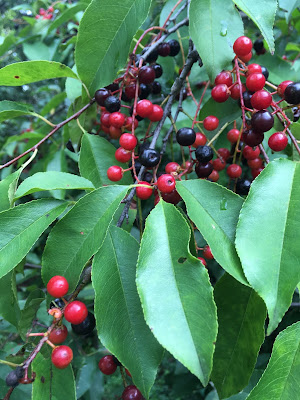 |
| Bleeding heart (Dicentra spectabilis) winding down |
Right in front of my kitchen window, a large pot of cucumber vines was burgeoning until two weeks ago, opening new yellow flowers and forming perfect little fruits that grew into delicious cucumbers much tastier than the waxed, store-bought versions.
 |
| July: cucumber vine flowering |
Last week the leaves started to shrivel. One morning I looked out and saw the plants had turned completely brown. Was it because of a night temperature in the 40s, or was it just time? How do plants know when to die?
 |
| September: the season for cucumbers has ended |
Like us, plants need to maximize their utility, acquiring as much as they can of life’s necessities—in their case, water, sunlight, nutrients, and space to grow. They can’t chase after these things. But unlike us, they can add to their bodies, growing new roots and shoots all their lives. Plants don’t just grow randomly. To respond to surrounding conditions, they make adjustments to their growth mediated by hormones carrying chemical messages from roots to leaves and back.
Each plant makes unsentimental decisions minute to minute about which parts will get more resources and which have to go. The plant is continuously gathering feedback from its extremities and expecting each unit to pull its weight. It needs each root to bring in enough water and nutrients to make it worth “paying for” with sugars made through photosynthesis in the leaves. Similarly, it needs each leaf to produce enough of those carbohydrates to support the roots in their mission.
 |
| One cranesbill leaf too many |
I learned that there are two kinds of plant senescence, the ways plant tissues die. There’s stress-related senescence. That's what happens when I forget to water a container plant and some leaves turn yellow and die because the plant didn’t have enough water to support them. Those leaves became too expensive to support in drought conditions.
 |
| Elephant ear leaf saying, "Why didn't you water me?" |
The other way of plant death is pre-programmed for the end of the growing season. My cucumber vines (Cucumis sativus) are annuals, born to die about 70 days from planting, soon after they finish producing fruit. This strategy allows an annual species to put all its energy into preserving genetic diversity. As leaves get ready to drop, the plant pulls back nutrients they held and uses those nutrients to produce lots of seeds, each with a mix of genes from its parents.
Shrubs, trees, and perennials such as bloodroot (Sanguinaria canadensis) have chosen another option.
 |
| Yellowing bloodroot leaves sending resources back to the roots |
They store nutrients in roots and stems to use later. That gives them a jump on the annuals when spring comes. They’re poised to send up new shoots, push out new leaves and roots, and get the most from the early spring sunlight.
 |
| Bloodroot leaves and flowers opening in April |
I hate to see winter coming and the garden season ending, but it’s great to picture the plants laying up stores for next spring.



























